
This media resources page provides members of the media with information; resources; and broadcast-, print-, and web-quality imagery developed during the 2016 Deepwater Exploration of the Marianas: expedition.
From April 20 to July 10, 2016, NOAA Ship Okeanos Explorer will investigate and document deepwater environments in and around the Commonwealth of the Northern Mariana Islands (CNMI) and the Marianas Trench Marine National Monument (MTMNM).
During the 2016: Deepwater Exploration of the Marianas expedition, our at-sea and shore-based science teams will work together to make some of the first deepwater scientific observations in this area. The expedition will commence and conclude in Guam and will also include a port call in Saipan, CNMI.
Planned expedition dates are as follows:
Note: The above dates are Chamorro Standard Time and are a day ahead of the mainland U.S., Hawaii, and Alaska. ROV operations in the mainland U.S. are planned daily from April 20 through May 9 and June 17 through July 8.
On this page:
Why? | Who? | Highlight Videos & Images | Press Releases | Background Info | Contact Info
This expedition is part of the three-year Campaign to Address the Pacific monument Science, Technology, and Ocean NEeds (CAPSTONE), a foundational science effort focused on deepwater areas of U.S. marine protected areas in the central and western Pacific. The investment provides timely, actionable information to support decision making based on reliable and authoritative science. It also serves as an opportunity for the nation to highlight the uniqueness and importance of these national symbols of ocean conservation.
Located in the Mariana Archipelago east of the Philippines, the Marianas Trench Marine National Monument includes approximately 250,000 square kilometers of submerged lands and waters. This unique place is made up of three units: the Islands, Trench, and Volcanic units.
Only recently have scientists visited the realm of the Monument, where they observed previously unknown biological, chemical, and geological wonders of nature. These deep areas likely include many secrets yet to be discovered during this expedition.
The expedition will provide a foundation of publicly accessible baseline data and information to support science and management needs in and around Guam, the Commonwealth of the Northern Mariana Islands (CNMI), and the Marianas Trench Marine National Monument (MTMNM). The effort also provides critical information about emerging regional issues like deep-sea mining and the potential U.S. Extended Continental Shelf.
The objectives for this expedition are:
The expedition will include 24-hour operations consisting of remotely operated vehicle (ROV) dives and mapping operations.
This is the fourth expedition in a three-year NOAA campaign to explore and understand the central and western Pacific marine national monuments and sanctuaries. Other focus areas of the 2016 field season include the Papahānaumokuākea Marine National Monument and the Wake Atoll section of the Pacific Remote Islands Marine National Monument, now known as Pacific Islands Heritage Marine National Monument.
In 2017, field activities will shift back to the central Pacific and likely include areas extending from the vicinity of the Hawaiian Archipelago south to the equator. Priority areas include Kingman Reef and Palmyra Atoll, Jarvis Island, Howland and Baker Islands, and the Johnston Atoll portions of Pacific Remote Islands Marine National Monument; the National Marine Sanctuary of American Samoa; and Rose Atoll Marine National Monument. Additional work in the Phoenix Islands Protected Area and Musicians Seamounts is also under consideration.
The expedition involves a number of NOAA partners including National Marine Fisheries Service’s Pacific Islands Fisheries Science Center, Pacific Islands Regional Office, and Office of Habitat Conservation's Deep-sea Coral Research and Technology Program; Office of Marine and Aviation Operations; NESDIS National Centers for Environmental Information; and Office of Oceanic and Atmospheric Research’s Office of Ocean Exploration and Research.
The individuals listed below will primarily lead the activities during the expedition. They will coordinate input from multiple scientists participating from shore to plan dives, and are the voices you hear on the live video feeds and the primary participants in outreach events. For a full list of our on-ship team, please visit this page.
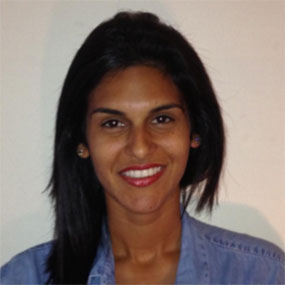
University of Hawaii at Manoa
April 20 – May 11: ROV and mapping focused on the southern part of the CNMI and the MTMNM
Diva Amon is a deep-sea ecologist with a special interest in chemosynthetic habitats and anthropogenic impacts in the deep sea. In 2013, she completed her Ph.D. jointly at the University of Southampton and the Natural History Museum in London, United Kingdom. Since then, she has been a postdoctoral fellow in the Department of Oceanography at the University of Hawai’i at Manoa. Currently, her work is focused on understanding what megafauna inhabit the largely unknown deep sea of Clarion-Clipperton Zone in the Pacific Ocean, in advance of the mining of this region for polymetallic nodules. Her doctoral research focused on the ecology of chemosynthetic environments, such as hydrothermal vents, wood falls, and whale falls.
Although this is Diva’s 13th deep-sea expedition, she has never worked in the western Pacific Ocean before. Having been born and raised in Trinidad and Tobago, she is comfortable working in the tropics and is looking forward to her time in the Commonwealth of the Northern Mariana Islands and the Marianas Trench Marine National Monument.
You can find out more information about Diva on Twitter (@DivaAmon ) or by visiting her website (www.divaamon.com ).
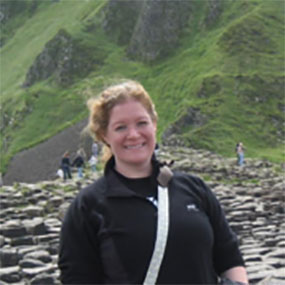
Associate Director, NOAA Cooperative Institute for Ocean Exploration, Research, and Technology
April 20 – May 11: ROV and mapping focused on the southern part of the CNMI and the MTMNM
Deb Glickson is a marine geologist with a background in hydrothermal vent geology. She received her Ph.D. in Oceanography from the University of Washington in 2007, and also holds an M.S. in Geology from Vanderbilt University and a B.S. in Geology from the University of Florida. Her doctoral research focused on the magmatic and tectonic evolution of the Endeavour hydrothermal vent fields.
After earning her Ph.D., Deb moved into science policy, where she used her background in geology and oceanography to advise federal and state governments. She is currently the Associate Director of the NOAA Cooperative Institute for Ocean Exploration, Research, and Technology.
Deb has sailed on 16 previous deep-sea research expeditions in the Atlantic, Pacific, and Indian Oceans, but has never been to the Marianas. She has explored the seafloor with autonomous vehicles, remotely operated vehicles, and manned submersibles, as well as the Lost City hydrothermal vent field through a prior NOAA telepresence-enabled cruise. She is very excited to explore the Marianas Trench Marine National Monument; visit the Commonwealth of the Northern Mariana Islands; and see the diverse and unique hydrothermal vent systems, geology, and biological communities that are associated with the region.
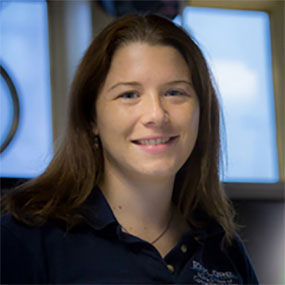
NOAA Office of Ocean Exploration and Research
April 20 – May 11: ROV and mapping focused on the southern part of the CNMI and the MTMNM
Kelley Elliott is the Senior Expedition Manager for NOAA’s Office of Ocean Exploration and Research. She holds a master’s degree in maritime archaeology from the University of Southampton and a bachelor’s degree in environmental conservation from George Mason University. Ms. Elliott is responsible for planning, coordinating, and managing expeditions conducted by NOAA Ship Okeanos Explorer. She has coordinated a dozen Okeanos expeditions since 2009, including eight that have pushed the frontiers of shore-based participation via telepresence.
Over the last decade, her combined professional and academic field experiences have taken her around the globe to investigate a diversity of science topics from Arctic Ocean ecology, tropical ecosystems, and submerged cultural heritage to deep-sea ecosystems, including hydrothermal vents, gas seeps, submarine canyons, and deep-sea coral habitats. An explorer at heart, Ms. Elliott spends most of her spare time exploring the great outdoors, from the volcanoes of Nicaragua to the trails surrounding her home in Reston, Virginia.
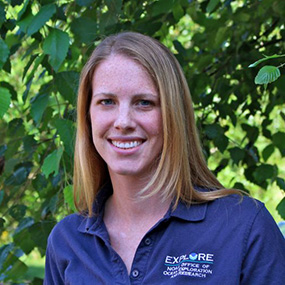
NOAA Office of Ocean Exploration and Research (ERT)
April 20 – May 11: ROV and mapping focused on the southern part of the CNMI and the MTMNM
Lindsay earned her master's in Ocean Mapping from the University of New Hampshire in 2013 and her bachelor's degree in Geological Sciences from Brown University in 2007. Lindsay worked as a geologist in the environmental field for three years before returning to graduate school. In graduate school, Lindsay gained practical seafloor-mapping experience during research cruises to the Mediterranean Sea and Arctic Ocean. Lindsay joined the Ocean Exploration program in early 2014 as a Mapping Team Lead, where she is responsible for the ocean mapping systems onboard the NOAA Ship Okeanos Explorer. At sea, Lindsay produces maps that are used to direct the exploration process and plans the day-to-day mapping routes to ensure the ship is always exploring efficiently.
On shore, Lindsay works at the Integrated Ocean and Coastal Mapping Center at the University of New Hampshire where she contributes to expeditions through data processing and archiving, operational planning, and mapping product development. Lindsay resides in Rye, New Hampshire.
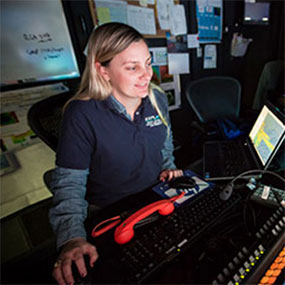
NOAA Office of Ocean Exploration and Research (ERT)
May 30 – June 11: Mapping focused on the northern part of the CNMI and the MTMNM
Elizabeth (Meme) Lobecker is a physical scientist with NOAA’s Office of Ocean Exploration and Research. She has led or sailed on over 20 cruises on NOAA Ship Okeanos Explorer. When working on shore, she is located at the Integrated Ocean and Coastal Mapping center at the University of New Hampshire, where she plans Okeanos Explorer mapping operations and cruises, facilitates data archival procedures with the National Geophysical Data Center, and collaborates with other scientists on Okeanos Explorer missions.
Ms. Lobecker began her career in hydrography in 2002 at Science Applications International Corporation, Inc. (SAIC, now Leidos), where she spent five years mapping the U.S. East Coast, the Gulf of Mexico, and Alaska, primarily for NOAA and U.S. Geological Survey contracts. She was also an in-house software tester for SAIC’s multibeam acquisition and processing software suite. In 2007, Ms. Lobecker left SAIC to diversify her survey experience through fieldwork in Papua New Guinea, the North Sea, and the Mediterranean Sea for various research and commercial purposes.
She holds a master’s degree in marine affairs from the University of Rhode Island and a bachelor’s degree in environmental studies, with minors in geography and biology, from The George Washington University.
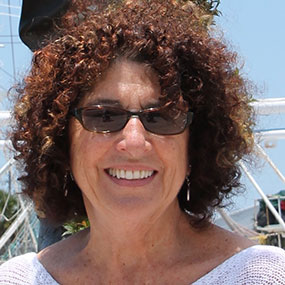
Research Professor and Executive Director of the NOAA Cooperative Institute for Ocean Exploration, Research, and Technology, Harbor Branch Oceanographic Institute, Florida Atlantic University; Professor of Marine Biotechnology at Wageningen University, Netherlands
June 17 – July 10: ROV and mapping focused on the northern part of the CNMI and the MTMNM
Shirley Pomponi is Research Professor and Executive Director of the NOAA Cooperative Institute for Ocean Exploration, Research, and Technology, Harbor Branch Oceanographic Institute, Florida Atlantic University, and Professor of Marine Biotechnology at Wageningen University, Netherlands. She received her Ph.D. in Biological Oceanography from the University of Miami.
Shirley's research interests are sponges—their biology, taxonomy, ecology, chemistry, molecular biology, and cell culture. She's particularly interested in developing in vitro (i.e., cell culture) techniques to study why and how sponges produce chemicals that may be developed into drugs to treat diseases like cancer and Alzheimer's.
Although she spends much of her time doing research administration, the best part of her job is conducting fieldwork, especially undersea exploration. She has led numerous research expeditions worldwide and has made more than 300 dives in Harbor Branch's Johnson-Sea-Link manned submersibles. Diving in the Mariana Trench has been on Shirley's bucket list for a long time, so she's especially excited to be participating in this mission.
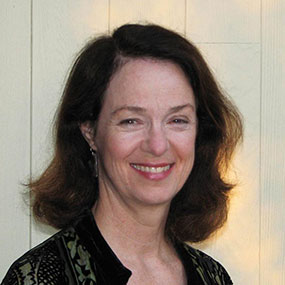
NOAA Office of Ocean Exploration and Research (ERT)
June 17 – July 10: ROV and mapping focused on the northern part of the CNMI and the MTMNM
Patricia Fryer, Ph.D., is a marine geologist interested in all aspects of lithospheric plate subduction, the process that forms ocean trenches and island arcs. She is a veteran of 46 marine research expeditions, often in the role of chief scientist, and her research has focused on the very deepest parts of the Mariana Trench, including the question of why the Challenger Deep is so deep. She also has an active interest in serpentine mud volcanoes formed as a consequence of subduction and deformation of the Mariana plate above the subduction zone.
Patty has dived in the submersibles Alvin and Shinkai 6500 and has conducted expeditions with remotely operated vehicles (ROVs) in the Mariana region.
She received her college degree in geology from the College of William and Mary and her graduate degrees in geology and geophysics from the University of Hawai`i at Manoa.
She works on samples of sediment and rocks from the Mariana Trench region to understand not only the physical and chemical processes responsible for their origins, but to collaborate with biologists to determine the implications of microbial communities observed thriving on serpentinized peridotite (mantle rock) contained in the mudflows from the serpentinite volcanoes and exposed in the deepest parts of the trench slope.
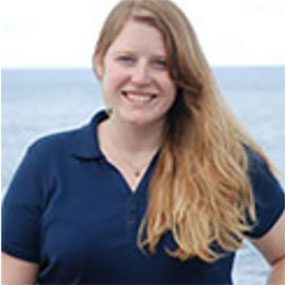
NOAA Office of Ocean Exploration and Research (Collabralink)
June 17 – July 10: ROV and mapping focused on the northern part of the CNMI and the MTMNM
Kasey Cantwell is a Field Operations Specialist with NOAA's Office of Ocean Exploration and Research. Kasey has a Master of Science degree in Marine Affairs and Policy and Marine Geology and Gepophysics and a Bachelors of Science degree in Marine Science and Biology, both from the University of Miami Rosenstiel School of Marine and Atmospheric Science.
Kasey’s background includes field work on coral reefs throughout the Caribbean, long-term ecosystem monitoring, and evaluating resource management strategies.
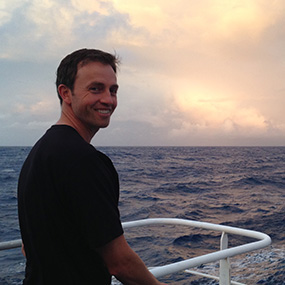
NOAA Office of Ocean Exploration and Research (ERT)
June 17 – July 10: ROV and mapping focused on the northern part of the CNMI and the MTMNM
Derek Sowers is a physical scientist/hydrographer with the NOAA Office of Ocean Exploration and Research. During at-sea expeditions, he leads sonar data collection by planning the ship’s mapping routes and producing maps of seafloor and water column features to guide exploration. On shore, Mr. Sowers works at the Center for Coastal and Ocean Mapping/Joint Hydrographic Center at the University of New Hampshire to coordinate future mapping expeditions, process and archive data, and collaborate with other scientists. He has fourteen years of previous coastal research and management experience, including with NOAA’s National Estuarine Research Reserve network and EPA’s National Estuary Program, in both Oregon and New Hampshire. Mr. Sowers has participated in ocean research expeditions in the Arctic Ocean, Gulf of Maine, Gulf of Mexico, Pacific Northwest continental shelf, North Atlantic Canyons, and New England Seamounts. He holds a B.S. in environmental science from the University of New Hampshire and an M.S. in marine resource management from Oregon State University. He is also a part-time oceanography PhD student focused on utilizing Extended Continental Shelf and Okeanos Explorer data to develop marine ecological classification maps.
Dive highlight videos, short video clips, and photos will be posted online as they are available.
Please contact Katie Wagner for high-res footage, B-roll, and other materials at (301) 734-1008 or Katie.Wagner@noaa.gov.
Access LIVE video feeds here
Expedition home page
Please see the Contact Us page for information regarding specific media, public, and government inquiries.